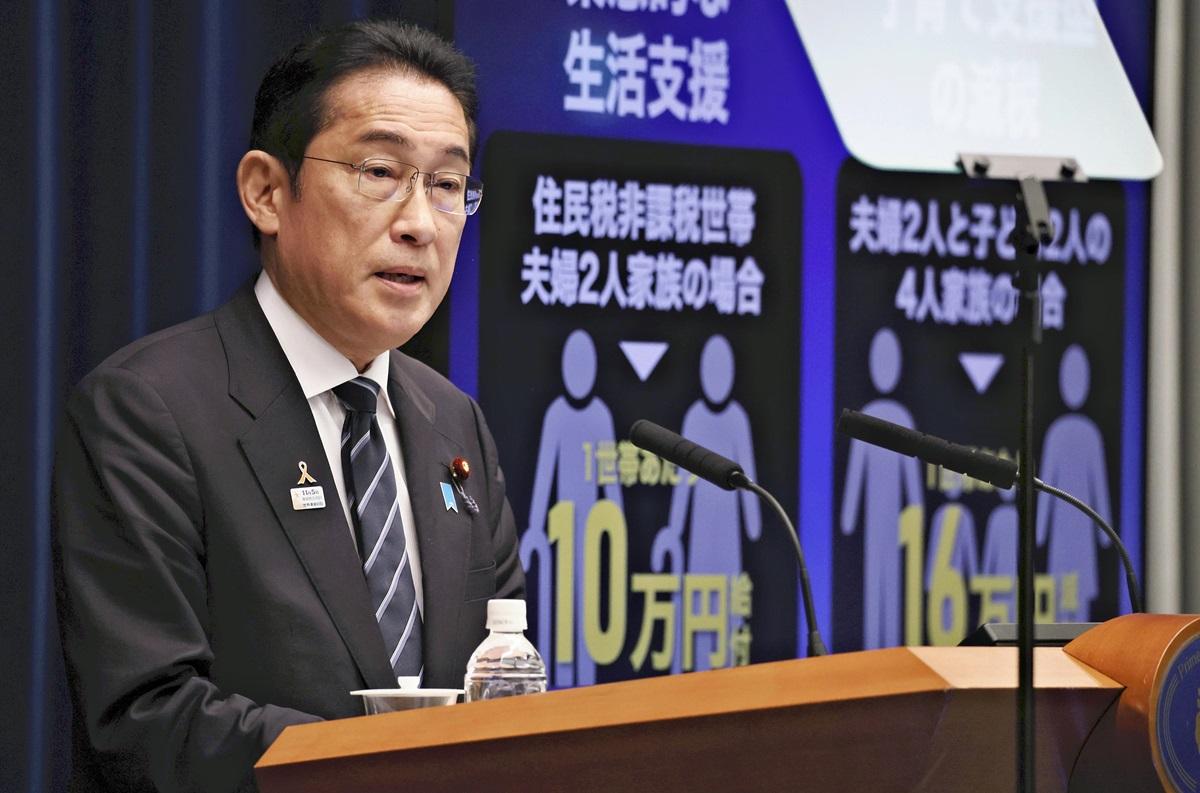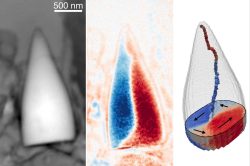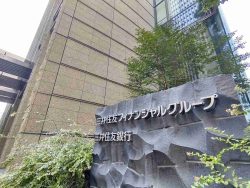Stimulus Package Set to Drive Greater Govt Borrowing; Likely Effectiveness Called into Question

Prime Minister Fumio Kishida explains an economic stimulus package at a press conference at the Prime Minister’s Office on Thursday.
18:26 JST, November 3, 2023
The economic stimulus package announced Thursday by the government is smaller than similar measures adopted in recent years, but its content is still a far cry from the government’s plan to return its spending structure to one suited to normal times.
Prime Minister Fumio Kishida had said he will “return” a portion of increased tax revenues accrued in recent years to the public, but the tax revenue is not growing as expected, leaving the nation’s finances to continue relying on government bond issuance. The government’s fiscal discipline remains lax.
In recent years, economic packages have ballooned as the government dealt with the COVID-19 pandemic and the rising cost of living. When Kishida addressed a policy roundtable of the government and ruling parties at the Prime Minister’s Office on Thursday morning, some attendees listened in astonishment as he outlined the priorities for this package. Kishida said that strengthening companies’ earning power and supply capacity would be the “most important pillar” of the measures.
Their surprise stemmed from the fact that at the roundtable’s previous meeting one week earlier, Kishida had stated that cutting income and residential taxes was “the most desirable” way to ease the burden of rising costs on the public. Kishida issued detailed instructions on fixed-amount tax reductions and cash benefits to low-income households.
But at Thursday’s meeting, Kishida’s emphasis on making tax cuts the most important item in the economic package had been replaced by positioning the need for strengthening companies’ supply capacity.
When Kishida instructed relevant Cabinet ministers to finalize new economic stimulus measures in September, he said the increased tax revenue “should be appropriately returned” to the public and that dealing with soaring prices would be the first pillar of these measures. Promoting domestic investment to strengthen supply capacity was listed as the third pillar.
In September, when Kishida mentioned the keywords “increased tax revenue” and “returned,” the ruling parties and Finance Ministry were sent into a spin. Did “return” mean a tax cut or cash benefit? How much would tax revenue increase? Conjecture and speculation ran rampant.
Tax revenue has indeed grown as Japan’s economy rebounded from the COVID-19 pandemic, but even so, about 30% of spending in the initial fiscal 2023 budget was covered by government bonds. Under these circumstances, tax revenue and other sources of funding that could be returned to the public did not exist.
In the end, the government decided to cut income tax by ¥30,000 and residential taxes by ¥10,000 per person, an unusual step taken without prior discussions by the ruling parties’ research commission on the tax system. However, some observers have voiced skepticism about the economic impact of the tax cuts and criticized this move as a ploy aimed at wooing voters ahead of the next election. Kishida’s hope that these measures would give his administration a boost has fallen flat.
At a press conference held Thursday evening to discuss the economic package, Kishida did not say the previously frequently mentioned word “return” even once.
Hay fever, dementia measures
The economic package includes a range of measures, such as those aimed at increasing wages at small and midsize businesses and boosting domestic investment. Among policies crafted with an eye to bolstering industries expected to grow in the future was the establishment of a 10-year fund worth ¥1 trillion for the Japan Aerospace Exploration Agency. However, some measures had a tenuous link to economic stimulus, such as policies related to dementia and hay fever.
The government is expected to include general account spending of ¥13.1 trillion for the package in a supplementary budget. Although this represents a significant decrease in scale from the supplementary budgets that skyrocketed since fiscal 2020 during the coronavirus pandemic, the figure is still well above the supplementary budgets compiled until fiscal 2019 that hovered around ¥3 trillion. The government stipulated in the Basic Policy on Economic and Fiscal Management and Reform approved by the Cabinet in June that it would “return the spending structure to normal.” However, a senior government economic official, expressing a widely shared view, said, “It’s still not returning at all.”
The supply and demand gap, which indicates the difference between demand and potential supply capacity in the Japanese economy, has turned positive. There also are concerns that stimulating demand through this economic package could fan higher prices.
“It’s possible these measures could actually increase the burden on low-income earners,” said Kenta Domoto, a researcher at the Mitsubishi Research Institute. “Much of the cash benefits and tax cuts end up being stashed in people’s savings, so I doubt the measures will have an impact commensurate with the government’s expenditure.”
It is expected that the additional issuance of about ¥10 trillion in bonds will be unavoidable for the draft supplementary budget. Despite this, Kishida insisted at Thursday evening’s press conference, “Helping the economy grow is precisely the way to increase tax revenue and pave the way to fiscal consolidation.” However, if these latest measures do not generate economic growth, it is possible the government could find itself in a situation that requires repeatedly coughing up even larger outlays.
"Business" POPULAR ARTICLE
-

Govt Plans to Urge Municipalities to Help Residents Cope with Rising Prices
-

Japan Prime Minister Takaichi Vows to Have Country Exit Deflation, Closely Monitor Economic Indicators
-

Essential Services Shortage to Hit Japan’s GDP By Up to ¥76 Tril. By 2040
-

Japan GDP Down Annualized 1.8% in July-Sept.
-

JR East Suica’s Penguin to Retire at End of FY2026; Baton to be Passed to New Character
JN ACCESS RANKING
-

Govt Plans to Urge Municipalities to Help Residents Cope with Rising Prices
-

Japan Prime Minister Takaichi Vows to Have Country Exit Deflation, Closely Monitor Economic Indicators
-

Japan to Charge Foreigners More for Residence Permits, Looking to Align with Western Countries
-

Essential Services Shortage to Hit Japan’s GDP By Up to ¥76 Tril. By 2040
-

Japan GDP Down Annualized 1.8% in July-Sept.






















